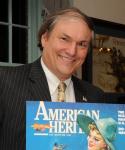The daughter of a Lebanese immigrant grew up to become Ronald Reagan’s chief of protocol and organized more state dinners than in any other presidency.
-
November/December 2025
Volume70Issue5

The journey of my life could only have happened because of two acts of immense daring by two immigrants to America. One was the courage of a fifteen-year old boy—my late father—who left his Lebanese mountain village, stowed away on a boat and, thanks to a sympathetic ship’s captain, was allowed to work his passage to America. Thus, my father arrived on these shores penniless, not speaking a word of English, and began his new life as a peddler. He eventually achieved a modest prosperity in the mountains of Tennessee, but he left me with the richest possible heritage—being born in America.
Three hundred years earlier, the first Roosevelt — Nicholas, by name — made an even more intrepid voyage — coming to America in the early 1600’s from a bleak, remote island in Holland. His progeny produced two great American presidents — and later my husband, Archie Roosevelt, Jr., a grandson of Teddy Roosevelt.
And so these two men, by acts 300 years apart, set in motion my own adventure.
Still, you might ask how this woman whose antecedents were from the tiny Lebanese village of Arsoun came to be Ronald Reagan’s Chief of Protocol, thus America’s hostess to the kings and queens, presidents and prime ministers, and other luminaries invited by the president, vice president, and secretary of state.
How did a first-generation American become the arbiter of what is correct and appropriate for American officials regarding protocol, and the planner of much of the nation’s official entertaining?

And how did she become the “nanny” of the diplomatic corps, settling questions of diplomatic privileges and immunity, with the power to declare a miscreant diplomat “persona non grata”?
How did a woman born and reared in the mountains of east Tennessee become the chatelaine of Blair House, the 110-room presidential guest house, overseeing its six-year restoration?
This could only happen in America. My journey is that miracle known as The American Dream. And it was small-town America and my loving Arab parents who gave me the roots and strength to make it possible.
After 20 years of perseverance and hard work in Kingsport, Tennessee, my father felt sufficiently prosperous to return to Lebanon to find a bride. He took one look at my beautiful teenage mother and persuaded her to elope with him to America. (I should add that Daddy did ask the patriarch of her family for her hand, but was soundly rejected.) Mother wanted to escape from an arranged marriage with an older, wealthy man, and she was lured by the idea of going to live in America.
Mother was not only beautiful, but brilliant, spoke fluent English and French, and was very perceptive. She was only 17 when I was born, and my sister came along two years later. As we were growing up, Mother did much to make us part of the community — no small feat in a town of White Anglo-Saxon Protestants. Even Catholics were viewed with suspicion, so you can imagine how Lebanese Druze might be perceived. However, Mother did not wait to find out. She decreed that there were many paths to God, and after looking over the Episcopalians, Presbyterians and Baptists, she decided that we should join the Methodist Church.
Eventually, she became president of the Tennessee League of Women Voters and was active in every important cultural and charitable endeavor in our hometown. But growing up in East Tennessee, where almost everyone was blonde and blue-eyed, was, in some ways, a searing experience. And to look as exotic as I did in the South of the 30’s and 40’s was to learn compassion for those who have suffered the indignities of racial or ethnic slurs. Often, I would complain to my mother about my looks, always wishing I had a cute turned-up nose. And she would counter: “a long nose is a mark of aristocracy.”
As you can see, Mother would not put up with self-pity. She convinced me I could do anything I set my mind to. So, with that upbringing, I made up my mind to go to Vassar College. This upset my father, who worried about the financial burden, but I worked every summer on the local newspaper and earned scholarships and graduated with honors.
At Vassar, I finally found the big world out there — where being of Lebanese origin was a plus — both glamorous and desirable. I made lifelong friends, such as Jackie Bouvier, later Kennedy, who were socially secure and fascinated by someone different. One of my roommates was Charlotte Curtis, who became the first female op-ed page editor of The New York Times.
It was Charlotte who encouraged me to write a defense of First Lady Nancy Reagan. (She was being pilloried in the press about the china, her designer clothes, and redecorating of the private quarters of the White House.) The appearance of my story — prominently featured on the op-ed page of the Washington Post — started me on that journey to the White House — a result I could never have imagined.
Just before graduating, I went to New York to be interviewed for a State Department job by a Mr. Archie Roosevelt. I met him on Saturday, and he asked me to marry him on Sunday. It was love at first sight for both of us — Maktoub: “It is written,” as Arabs say — and our happy marriage lasted 40 years, until his death.

Archie brought me love and laughter — the two greatest gifts a young bride could wish for. But there was also something I did not bargain for.
We had a wonderful life, with postings in Istanbul, Madrid, and finally London for five years. Archie was a great linguist and spoke Arabic fluently, as well as Persian, Turkish, and Hebrew, and could communicate in French, Russian, German, Spanish, and Italian. He was fascinated by the Middle East and loved the people whom he came to know long before I met him, when he served in World War II in Morocco, Algeria, Tunisia, and Egypt, as well as post-war in Iraq, Iran, and Lebanon.
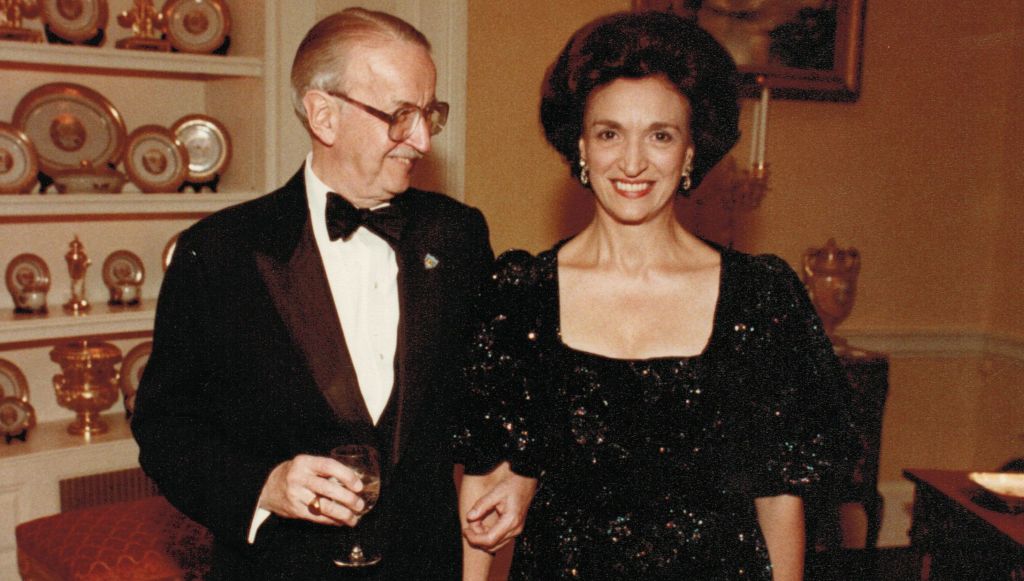
Together, we traveled extensively in the Middle East. And, all the while, I was acquiring the knowledge and experience that prepared me to step into the role of Chief of Protocol. For four years, I wrote a column called “Diplomatically Speaking” for the Washington Star, covering the State Department, the diplomatic corps, and White House state visits. I continued my journalistic career writing for magazines when we were home between assignments.
In fact, I was in Brazil on a story for Town & Country when I got the call which started me on the journey to the White House. When I got home, Mother told me that Mike Deaver, deputy chief of staff of the White House, had called. “But, Mother, why didn’t you give him my number in Brazil?” I asked.
“I didn’t think it was that important,” she said.
But I knew better. I had been in Bahia and, just before leaving, I visited a jewelry shop and my eye fell on a pretty Victorian gold locket trimmed with turquoise and seed pearls. Being of Mediterranean ancestry, I am convinced that turquoise keeps away the evil eye, so I reached for it and casually turned it over, and, to my amazement, there was a big letter “L” set in diamonds. My nickname being “Lucky,” I knew the locket was meant for me. I didn’t even haggle over the price.
What’s more, the date on Deaver’s message was the day I found the lucky locket! When I finally made contact with him, he asked me if I would accept the position of Chief of Protocol for President Reagan. I accepted without hesitation, and indeed, I felt that my life, up to that moment, had been in preparation for this exciting job. Little did I dream that I would serve for over seven years.
What wonderful years they were. For starters, I had three fabulous bosses — President Reagan, Vice President Bush, and Secretary of State Shultz.
In the course of my duties, I met and interacted with most of the important leaders in the world and I got to travel with the President on Air Force One. I had a staff of 72 and we were the office of record for more than 30,000 members of the diplomatic corps. We were the custodians of Blair House, the presidential guest house; we organized all of the Secretary of State’s entertaining; and we planned and executed more than 1,000 official visits of world leaders, but the most significant of these were the 70 state visits of heads of state or government.

More recent presidents have not understood the importance of state visits. The younger Bush only had about five such visits in eight years, the Obamas had only six or seven, and the Trump administration had only two.
But we regarded state visits and state dinners hosted by President and Mrs. Reagan as very important instruments of foreign policy, and we scheduled about one state visit a month. This way, the president could form a personal relationship with each visitor, We gave state dinners for almost every South and Central American country; we hosted every Middle Eastern and North African potentate, except for Ghadafi and Saddam Hussein; we had many leaders of the Sub-Sahara African countries, the major European countries, and the major Far Eastern countries.
We treated them all exactly alike — that is, a welcoming ceremony on the south lawn of the White House, followed by substantive meetings. A state dinner for about 130 guests, with a few more invited for after-dinner entertainment and dancing. More substantive meetings the next day, followed by a big lunch given at the State Department by Secretary Shultz, and the return dinner given by the visiting head of state. In my day, we gave the visitor an Air Force plane to take him and his entourage to major cities in the USA and I or my deputy accompanied them.
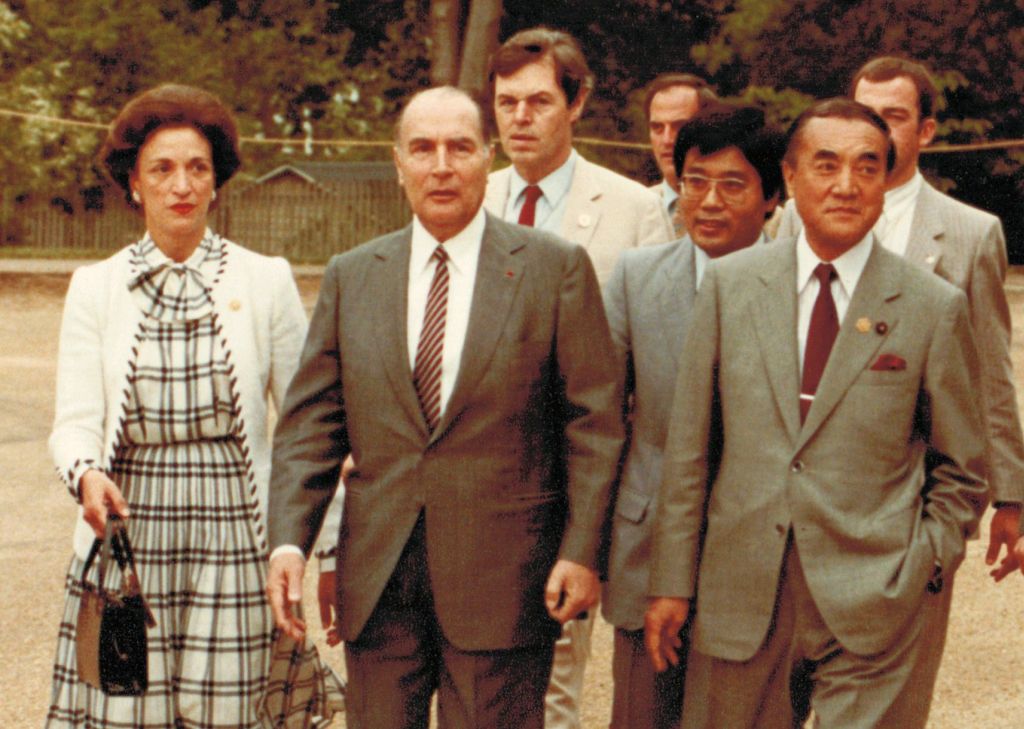
Occasionally, if the Congress was so inclined, the visitor was invited to speak to a joint session of Congress.
As I look back now, those were halcyon days.
I have a letter from President Reagan which I cherish. It reads, in part, “In the past few years, this administration has developed a special network of relationships with leaders all over the world. This is in no small measure due to their productive visits to Washington. Form and content are usually opposite sides of the same coin, and you, Lucky, have kept your side of the coin brightly polished. Nancy and I are deeply grateful.” You can see why I loved working for him.
***
Of course, everyone has a touch of schadenfreude in them, and people always want to know about the things that went wrong on my beat. In our first interview, Shultz said to me: “Lucky, if protocol goes well, no one even notices, but if there is a goof, it’s on the front page. Your job is to stay off the front pages.” No truer words were ever spoken.
I remember when Joseph Reed, my successor, forgot to place a footstool for the diminutive Queen of England to stand on while giving her remarks. All anyone could see was her hat, and the press dubbed it “the talking hat.”
Alas, the boo-boos do get in the way of the substantive discussions. I will never forget that awful moment when the wife of the Canadian ambassador slapped her social secretary in a fit of rage, in full view of the press — thus obliterating the news about the important accomplishments of the state visit of Prime Minister Brian Mulroney.
One of my worst moments came when the Japanese Crown Prince and Princess, now the Emperor and Empress, were to lay a wreath at the tomb of the Unknown Soldier.
***(Tell more of the story here?) (Maybe also about their visit to the museum to see the exhibition about the camps we herded the Japanese into during World War II)
But much worse happened early in my job, particularly at a dinner that Vice President Bush gave for Prime Minister Shamir of Israel. This was the first kosher dinner I had supervised, and of course I wanted more than anything to make it a great success.
Well, the food was a disaster, and Kay Graham, owner of the Washington Post, was the first person to tell me how awful it was. Still worse, the Singing Sergeants, a military group who entertained at our events from time to time, circled the head table and sang to our Israeli guest: “Soon, I’ll be done with the troubles of the world, I want to meet my Jesus.”
***
On a more serious note, when I see today the disarray in our relations with Russia, I think back on the years when I observed the extraordinary diplomatic success Shultz and Reagan achieved with Soviet Foreign Minister Eduard Shevardnadze and General Secretary Mikhael Gorbachev, which led to the end of the Cold War.
Reagan always wanted a better dialogue with the Soviets, but successive leaders — Brezhnev, Andropov, and Chernenko -each died after a brief time in office. In frustration, Reagan asked, “How can I forge a better relationship with the Soviet leaders when they keep dying on me?”
But when Gorbachev assumed power in March 1985, it was apparent that the Earth had moved, and Reagan lost no time in arranging a Geneva summit meeting with the new Soviet leader the following November. As President Reagan wrote in his memoirs, “I have always placed a lot of faith in the simple power of human contact in solving problems.”
And so began a series of ups and downs — Geneva, the Danilov affair, Reykjavík — and I had a chance to observe and participate in this diplomatic dance that resulted in so much success.
You can imagine the thrill I felt when Gorbachev arrived at Andrews Air Force base, to be welcomed as our first Soviet state visitor. I rushed up the stairs of the huge Russian airplane to greet the Gorbachevs. The Soviet leader, a man of great charm and humor, immediately dubbed me “Comrade Protocol.”
Normally, we needed almost a year to prepare a state visit, but for this visit, as important as it was, we only had six weeks. My counterpart, the Russian chief of protocol, Ambassador Vladimir Chernyshev, was a real smoothie — tall, handsome, speaking excellent English, and very professional. He was accompanied by a 14-person delegation. We worked so well together, and everything to do with the principals, even the preparations for the INF treaty signing, caused little friction.

However, the wives became a problem, and that matter was dumped in my lap. We had a separate program for Raisa Gorbachev, and the Russians insisted that she be accompanied by Mrs. Reagan, which was not unreasonable from a protocol point of view. However, Mrs. Reagan was just recovering from her mother’s death and breast cancer surgery and she was adamant: she could not accompany Raisa, and suggested that Mrs. Shultz take her place.
The Russians took this as a terrible affront. Protocol demanded that Mrs. Reagan be replaced by Barbara Bush, the next in rank. Their chief of protocol was desperate and appealed to me. Colin Powell, as chairman of the National Security Council, was also brought into the act. Then the Russians pulled a fast one and went directly to Mrs. Bush and asked her — and innocently, Mrs. Bush said yes — not knowing the back story. So, she withdrew and, in the end, Mrs. Shultz did accompany Raisa.
The truly heart-stopping moment came on the last day of the visit when we were in the usual 65-car motorcade going from the Russian residence to the White House. As we drove down Connecticut Avenue, Vice President Bush was in the front car with Gorbachev, and I was in the car behind them with Foreign Minister Eduard Shevardnadze.
Suddenly, the cars came to a screeching halt. I was stunned. Our Secret Service agents and the Russian security men leapt out of cars with guns drawn. They hustled the Vice President and Mr. Shevardnadze to the side. Could there have been a dangerous demonstration, I wondered, or maybe a heart attack? I looked ahead and there was Gorbachev pressing the flesh with a big crowd of Americans waiting to greet him. That night, this was the lead story on TV, and one young woman who was interviewed said, “That guy is a PR genius.”
This little drama simply demonstrated how Reagan and Gorbachev and Shultz and Shevardnadze were creating a normalization and cordiality between the two countries which had not been seen for many decades. Of course, President Reagan made a return state visit to Russia, and I was lucky enough to be part of his official delegation.
Russia, however, was not our only diplomatic success. We had visits from three Chinese leaders during those eight years, and the visit of President Li Xiannian brought me an exciting dividend. I accompanied President Li, from his arrival in Niagara Falls to Washington, Chicago, California, and finally Hawaii, where I bid him goodbye, when he said: “Ambassador Roosevelt, this has been such a wonderful trip and you have been with me all the way. I want to invite you and an entourage of your choosing to come to China as my guests. If you do not come, I will not allow any more high-level Chinese visitors to come to the USA.”
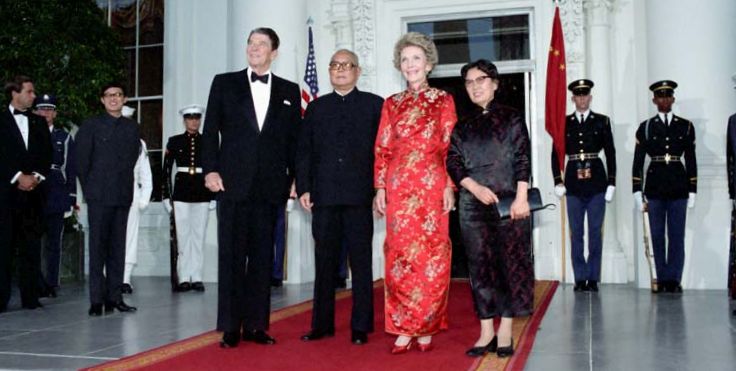
Accepting such a gift was highly unusual, to say the least, and I had to get permission from both the president and the Secretary of State. My husband and I and two friends spent almost three weeks in China and were feted everywhere. I never dreamed I was such a big shot until I learned that, in China, their head of protocol was the sixth-highest-ranking official in the government.
Prime Minister Margaret Thatcher was one of my favorite visitors. She came at least once a year. It was “Maggie” and “Ronnie” when the two leaders were together. Francois Mitterrand made several visits, but he was not easy to get along with, and Madam Mitterrand managed to disappear in San Francisco, much to the chagrin of the Secret Service. Maybe she was upset because Mitterrand had also brought a former mistress who was a cabinet officer.
Helmut Kohl of Germany was a bear of a man. He took huge strides and I had to run to catch up with him. But I also witnessed one of the most important moments in modern European history when I accompanied him to a meeting with the Senate Foreign Relations Committee. He told the senators that he intended to unify Germany, and, in a sense, dared them to stop him.
See “Stormy Weather for Queen Elizabeth” by Selwa Roosevelt
in the November/December 2022 American Heritage
Unlike today, the world was full of leaders with star quality. I think of Queen Elizabeth, with whom I spent 10 days when she and Prince Philip came on a state visit to California. I think of King Juan Carlos of Spain, a frequent visitor. I think of Indira Gandhi, who was assassinated, and her son Rajiv, who succeeded her, who both came on state visits. King Hussein of Jordan was an annual visitor. Canada’s Mulroney and Mexico’s de la Madrid, as well as Japan’s Nakasone ... The list is long.

During those seven years, I was given another task — the restoration of Blair House, which was not really in my job description. The presidential guest house across the street from the White House is managed and staffed by the chief of protocol. It was in such a bad state of repair that it was actually dangerous, and the White House felt it should be closed for renovation. At the time, Blair House consisted of four town houses scotch-taped together to form a complex of 110 rooms. Before we finished, six years later (it was closed all that time), we had spent almost $10 million in appropriated funds and $7 million in private funds to produce a seamless house that was second only to the White House in history and beauty.
We hit a snag in Congress when we went to the Hill for the money. There were some who said “we should tear it down and build something modern and efficient.” A particularly vociferous critic was Senator James Abdnor of South Dakota, a crusty bachelor of Lebanese-American descent. He had cut our appropriation from $9 million to $3 million.
Aha, I thought, I will go to his office and make a plea for the full funding. The interview got off to a bad start. “How can anyone spend that much money on a house? My constituents in South Dakota would never understand.” And he went on for a while in that vein.
Finally, I had to play my last card. “Senator, I don’t understand why you want to give me such a hard time. I’m just a nice Lebanese-American trying to do her patriotic duty!” He was surprised, because obviously Roosevelt is not an Arab name! As I left, I said, “If you like Lebanese food, my mother and I would be happy to invite you for a delicious meal that she will cook!” For the first time, he smiled. A few days later, I learned that the money had been restored.
So that we would not have to be dependent on Congress for anything to do with decorating, I insisted on leaving a nest egg of $1 million from the private donations which formed the beginning of the Blair House Restoration Fund. I have been the chair of this group for many years, and it has grown ten-fold, which makes it possible to keep the house in excellent condition. In 2015 (check), celebrating my 30 years of devotion to Blair House, President Obama honored me with a presidential commendation in the Oval Office.
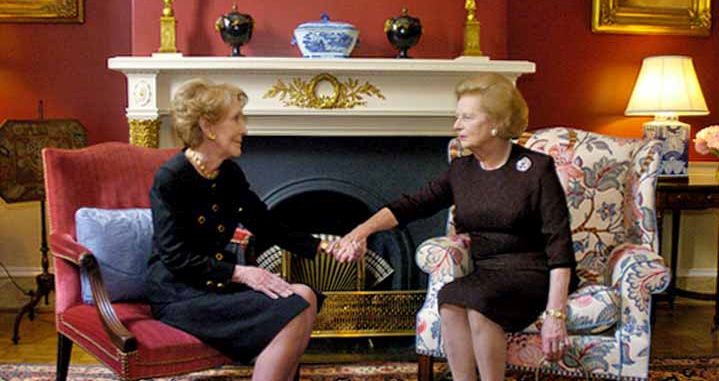
However, no life is free from tragedy and loss, and I had to face life without Archie when he died in 1990 of congestive heart failure. After a period of mourning, I found great solace in music, especially opera, and decided to devote my “golden years” to promoting the performing arts.
I had met the great Spanish tenor, Placido Domingo, when I accompanied the queen of Spain on a visit she made to Washington in the 1980’s to honor Placido when he sang the title role in the opera Goya, which had been written for him. Over the years, Placido and his wife Marta became good friends of mine and, in the early 90’s, I was asked by the board of the Washington National Opera to approach the great maestro about taking over our company. It took me six months to convince him, and he ran our opera company for 15 years, retiring in 2010.
The devotees of opera form quite a family. As a widow, I was thrilled to bond with this international group that was led by the Domingos. I spread my wings to Russian opera as well and joined the board of the Mariinsky Foundation of America, a supporting organization for their opera, ballet, and the symphony of St. Petersburg, under the leadership of maestro Valery Gergiev.
My opera pilgrimages have taken me to Verona, Florence, Rome, and Milan’s La Scala in Italy, to Madrid and Seville in Spain, to London’s Royal Opera House, Glyndbourne and Garsington in England, Moscow and St. Petersburg, Paris and the Roman arena of Orange in the south of France, to Bonn, Munich and Berlin in Germany, and the Salzburg music festival in Austria. And of course, all over the USA — to the Met in New York, as well as to Chicago, San Francisco, Los Angeles, Houston and Dallas and the Glimmerglass and Santa Fe festivals.

I have become friends with many opera singers and conductors and other personalities in the music world, and they have enriched my life enormously.
And so, to go back to the Greek poet, Constantine Cavafy, my voyage has been a long and exciting one. I have learned many things — perhaps the most important being that one must never despair over any experience, and when misfortune does strike, how we handle adversity is the most important test.
I have also learned on my journey that immediate rewards, though gratifying, do not always come to you and that recognition often comes when least expected. As Cavafy wrote:
“Setting out on the voyage to Ithaca,
you must pray that the way be long,
full of adventures and experiences.
But do not hurry the journey at all.
Better it should last many years.
Be quite old when you anchor at the island,
rich with all you have gained on the way.”

